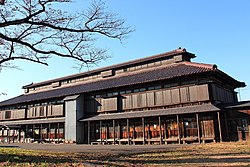132:
104:
35:
139:
111:
286:
visited the site, and gave it the name of "Matsugaoka". In 1873, and additional 204 hectares of mountain was cleared and the cultivation of tea, another important export crop, was also attempted. In 1874, on 311 hectares of open fields, 551,600 mulberry seedlings were planted. In 1875, the first
263:
of Shōnai Domain in the endeavor, which he organized into six companies. Initially, they began to cultivate the riverside of
Akagawa, in the eastern suburbs of Tsuruoka. Later that year, he organized an additional 3,000 former samurai into 34 companies and started the clearing of 106 hectares at
291:. The production of raw silk thread also began. From 1875 to 1877 a total of ten large buildings were constructed for the rearing of the silkworms, and eventually for the production of silk thread and silk cloth, and used
225:
and former
Imperial governor of the short-lived Sakata Prefecture, Suge Mitsuhide, started a large-scale raw silk cooperative farm in Fujishima Village, in what is now the city of Tsuruoka. The production of
131:
103:
61:
302:
In 1881, the "Matsuoka
Company Pledge" was signed by the 458 households who chose to remain with the project. A silk mill was constructed in 1887. In 1947,
337:
414:
409:
317:. In 1989, the building and surrounding area were designated as a National Historical Site. It is located bout 20 minutes by car from
424:
310:, the business still continues in this area with 64 families claiming descent of the original ex-Shōnai samurai pioneers.
299:. While many similar sericulture businesses were attempted around Japan at that time, none were on such a large scale.
419:
366:
212:
239:
296:
391:
313:
One of the sericulture buildings was preserved as a museum as it would have looked during the early
196:
192:
161:
48:
208:
318:
303:
231:
222:
383:
325:
342:
191:
Japan, for the production of silk thread and cloth. Its location, in the modern city of
184:
403:
283:
306:
visited the site. Although the demand for silk greatly diminished, especially after
314:
307:
265:
188:
34:
362:
268:. This involved the clearing of a large amount of forest and replanting it with
243:
242:
by the new government. Shōnai Domain has sided against the government in the
76:
63:
292:
235:
278:
288:
273:
269:
227:
322:
260:
256:
217:
251:
238:
much in demand overseas and thus a major supply of much-needed
138:
110:
246:, and faced severe financial and unemployment issues.
287:silkworms were raised and their cocoons shipped to
55:
44:
18:
234:as an industry of critical importance as it was a
176:
8:
338:List of Historic Sites of Japan (Yamagata)
33:
15:
259:relocated and initially hired 360 former
146:Matsugaoka Land Reclamation Area (Japan)
354:
7:
14:
137:
130:
109:
102:
197:National Historic Site of Japan
162:National Historic Site of Japan
121:Show map of Yamagata Prefecture
415:Museums in Yamagata Prefecture
272:trees, the source of food for
1:
295:salvaged from the demolished
410:1872 establishments in Japan
367:Agency for Cultural Affairs
213:abolition of the han system
172:Matsugaoka reclamation site
118:Matsugaoka reclamation site
19:Matsugaoka reclamation site
441:
183:was a cooperative farm on
178:松ヶ岡開墾場 Matsugaoka kaikonjō
177:
158:
96:
92:
32:
23:
392:Yamagata Prefecture site
264:Gotayama at the foot of
230:was targeted by the new
425:Historic Sites of Japan
384:Chido Museum home page
249:In 1872, Suge had the
77:38.70028°N 139.88611°E
82:38.70028; 139.88611
73: /
39:Matsugaoka kaikonjo
420:Tsuruoka, Yamagata
282:of Shōnai Domain,
193:Tsuruoka, Yamagata
49:Tsuruoka, Yamagata
209:Meiji restoration
169:
168:
149:Show map of Japan
432:
396:
388:
371:
370:
359:
319:Tsuruoka Station
304:Emperor Hirohito
240:foreign exchange
232:Meiji government
182:
180:
179:
150:
141:
140:
134:
122:
113:
112:
106:
88:
87:
85:
84:
83:
78:
74:
71:
70:
69:
66:
37:
16:
440:
439:
435:
434:
433:
431:
430:
429:
400:
399:
394:
386:
380:
375:
374:
365:(in Japanese).
361:
360:
356:
351:
334:
326:Uetsu Main Line
297:Tsuruoka Castle
205:
174:
165:
164:
154:
153:
152:
151:
148:
147:
144:
143:
142:
125:
124:
123:
120:
119:
116:
115:
114:
81:
79:
75:
72:
67:
64:
62:
60:
59:
40:
27:
12:
11:
5:
438:
436:
428:
427:
422:
417:
412:
402:
401:
398:
397:
389:
379:
378:External links
376:
373:
372:
353:
352:
350:
347:
346:
345:
340:
333:
330:
276:. The former
255:of the former
204:
201:
185:reclaimed land
167:
166:
160:
159:
156:
155:
145:
136:
135:
129:
128:
127:
126:
117:
108:
107:
101:
100:
99:
98:
97:
94:
93:
90:
89:
57:
53:
52:
46:
42:
41:
38:
30:
29:
21:
20:
13:
10:
9:
6:
4:
3:
2:
437:
426:
423:
421:
418:
416:
413:
411:
408:
407:
405:
395:(in Japanese)
393:
390:
387:(in Japanese)
385:
382:
381:
377:
368:
364:
358:
355:
348:
344:
341:
339:
336:
335:
331:
329:
327:
324:
320:
316:
311:
309:
305:
300:
298:
294:
290:
285:
284:Sakai Tadaaki
281:
280:
275:
271:
267:
262:
258:
254:
253:
247:
245:
241:
237:
233:
229:
224:
223:Shōnai Domain
220:
219:
214:
210:
202:
200:
198:
194:
190:
186:
173:
163:
157:
133:
105:
95:
91:
86:
58:
54:
50:
47:
43:
36:
31:
26:
22:
17:
357:
343:Chidō Museum
315:Meiji period
312:
308:World War II
301:
277:
266:Mount Gassan
257:post station
250:
248:
216:
206:
189:Meiji period
171:
170:
24:
215:, a former
195:, became a
80: /
68:139°53′10″E
56:Coordinates
25:Native name
404:Categories
349:References
293:roof tiles
244:Boshin War
207:After the
199:in 1989.
65:38°42′01″N
274:silkworms
236:cash crop
363:"松ヶ岡開墾場"
332:See also
289:Yokohama
270:mulberry
228:raw silk
211:and the
203:Overview
45:Location
323:JR East
321:on the
261:samurai
51:, Japan
279:daimyō
252:honjin
28:松ヶ岡開墾場
218:karō
221:of
187:in
406::
328:.
369:.
181:)
175:(
Text is available under the Creative Commons Attribution-ShareAlike License. Additional terms may apply.


